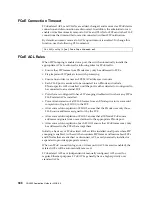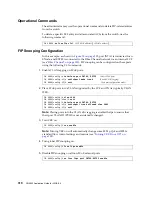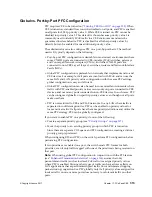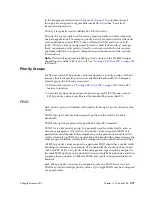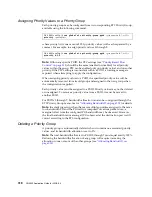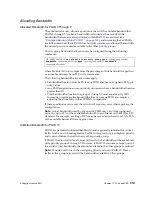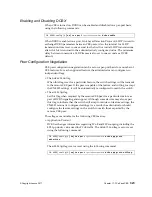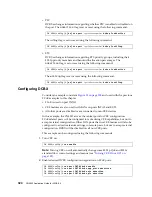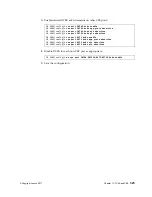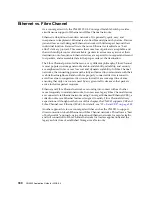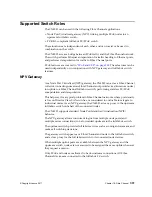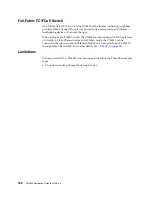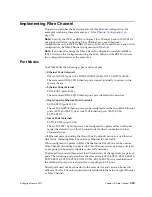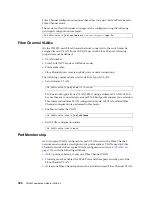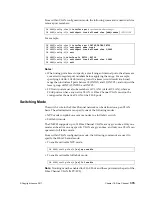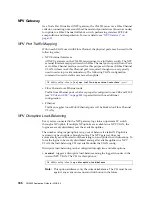
322
CN4093 Application Guide for N/OS 8.4
Data Center Bridging Capability Exchange
Data
Center
Bridging
Capability
Exchange
(DCBX)
protocol
is
a
vital
element
of
CEE.
DCBX
allows
peer
CEE
devices
to
exchange
information
about
their
advanced
capabilities.
Using
DCBX,
neighboring
network
devices
discover
their
peers,
negotiate
peer
configurations,
and
detect
misconfigurations.
DCBX
provides
two
main
functions
on
the
CN4093:
Peer
information
exchange
The
switch
uses
DCBX
to
exchange
information
with
connected
CEE
devices.
For
normal
operation
of
any
FCoE
implementation
on
the
CN4093,
DCBX
must
remain
enabled
on
all
ports
participating
in
FCoE.
Peer
configuration
negotiation
DCBX
also
allows
CEE
devices
to
negotiate
with
each
other
for
the
purpose
of
automatically
configuring
advanced
CEE
features
such
as
PFC,
ETS,
and
(for
some
CNAs)
FIP.
The
administrator
can
determine
which
CEE
feature
settings
on
the
switch
are
communicated
to
and
matched
by
CEE
neighbors,
and
also
which
CEE
feature
settings
on
the
switch
may
be
configured
by
neighbor
requirements.
The
DCBX
feature
requires
CEE
to
be
turned
on
(see
DCBX Settings
When
CEE
is
turned
on,
DCBX
is
enabled
for
peer
information
exchange
on
all
ports.
For
configuration
negotiation,
the
following
default
settings
are
configured:
Application
Protocol:
FCoE
and
FIP
snooping
is
set
for
traffic
with
802.1p
priority 3
PFC:
Enabled
on
802.1p
priority
3
ETS
Priority
group
0
includes
priority
values
0
through
2,
with
bandwidth
allocation
of
10%
Priority
group
1
includes
priority
value
3,
with
bandwidth
allocation
of
50%
Priority
group
2
includes
priority
values
4
through
7,
with
bandwidth
allocation
of
40%
Summary of Contents for Flex System Fabric CN4093
Page 27: ... Copyright Lenovo 2017 27 Part 1 Getting Started ...
Page 28: ...28 CN4093 Application Guide for N OS 8 4 ...
Page 58: ...58 CN4093 Application Guide for N OS 8 4 ...
Page 72: ...72 CN4093 Application Guide for N OS 8 4 ...
Page 85: ... Copyright Lenovo 2017 85 Part 2 Securing the Switch ...
Page 86: ...86 CN4093 Application Guide for N OS 8 4 ...
Page 98: ...98 CN4093 Application Guide for N OS 8 4 ...
Page 112: ...112 CN4093 Application Guide for N OS 8 4 ...
Page 136: ...136 CN4093 Application Guide for N OS 8 4 ...
Page 156: ...156 CN4093 Application Guide for N OS 8 4 ...
Page 192: ...192 CN4093 Application Guide for N OS 8 4 ...
Page 228: ...228 CN4093 Application Guide for N OS 8 4 ...
Page 229: ... Copyright Lenovo 2017 229 Part 4 Advanced Switching Features ...
Page 230: ...230 CN4093 Application Guide for N OS 8 4 ...
Page 298: ...298 CN4093 Application Guide for N OS 8 4 ...
Page 382: ...382 CN4093 Application Guide for N OS 8 4 ...
Page 392: ...392 CN4093 Application Guide for N OS 8 4 ...
Page 416: ...416 CN4093 Application Guide for N OS 8 4 ...
Page 452: ...452 CN4093 Application Guide for N OS 8 4 ...
Page 466: ...466 CN4093 Application Guide for N OS 8 4 ...
Page 496: ...496 CN4093 Application Guide for N OS 8 4 ...
Page 508: ...508 CN4093 Application Guide for N OS 8 4 ...
Page 510: ...510 CN4093 Application Guide for N OS 8 4 ...
Page 514: ...514 CN4093 Application Guide for N OS 8 4 ...
Page 538: ...538 CN4093 Application Guide for N OS 8 4 ...
Page 539: ... Copyright Lenovo 2017 539 Part 7 Network Management ...
Page 540: ...540 CN4093 Application Guide for N OS 8 4 ...
Page 554: ...554 CN4093 Application Guide for N OS 8 4 ...
Page 576: ...576 CN4093 Application Guide for N OS 8 4 ...
Page 596: ...596 CN4093 Application Guide for N OS 8 4 ...
Page 604: ...604 CN4093 Application Guide for N OS 8 4 ...
Page 609: ... Copyright Lenovo 2017 609 Part 9 Appendices ...
Page 610: ...610 CN4093 Application Guide for N OS 8 4 ...
Page 626: ...626 CN4093 Application Guide for N OS 8 4 ...
Page 633: ......
Page 634: ...Part Number 00MY375 Printed in USA IP P N 00MY375 ...

